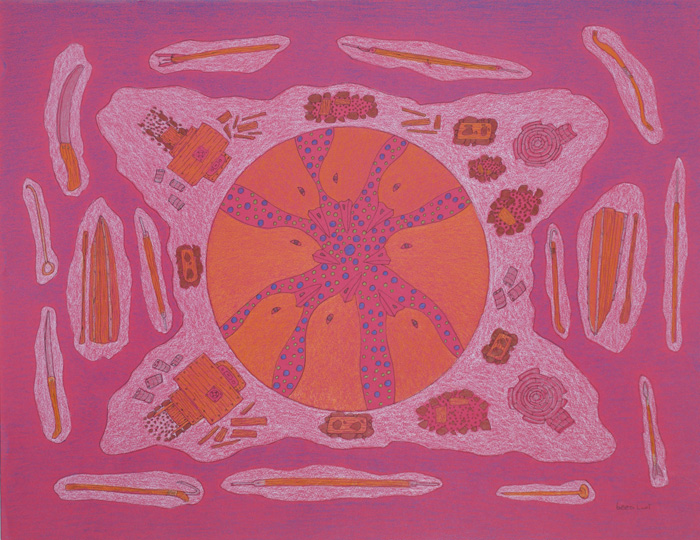Cold Dream: Drawings by Qavavau Manumie

The Marion Scott Gallery is pleased to announce an exhibition of drawings by Qavavau Manumie. Cold Dream: Drawings by Qavavau Manumie is MSG’s second exhibition of works by the Kinngait-based artist. Comprising 16 works on paper produced across the last eight years, the exhibition will showcase Manumie’s surreal sensibility and meticulous drawing style, bringing into focus the full range of his imaginative expression. Included in the show are representations of wildlife, compositions incorporating images of animals, humans and traditional objects, and landscapes.
At 57, Qavavau Manumie is part of a new generation of Inuit drawers who are reshaping the expressive traditions that were successfully pioneered by their parents and grandparents in the 1960s and 1970s. In a style that is spare, gentle and precise, Manumie’s delicately coloured pencil and ink images address themes ranging from man’s relationship to nature to the role of pictorial representation in art. Using motifs drawn mostly from traditional Inuit culture, Manumie transforms these themes into dream-like images of surprising originality and complexity, reflecting an artistic vision that is unique and contemporary.
Manumie is especially well known for his sensitive renderings of various species of birds. While mainly naturalistic in style and execution, these works transcend simple illustration, as the examples in the exhibition attest. In a drawing from 2007, Manumie has freely combined parts belonging to two different species in order to create a new, wonderfully strange hybrid creature. In another image, also from 2007, Mannumie represents a duck’s head together with its two webbed feet, isolating each part on the white page in a manner recalling collage. Whatever their compositional context, Manumie’s birds often wear gentle expressions, making them seem at times almost human.
Other works in the exhibition combine representational and abstract approaches. In an image from 2008, the heads of people and various marine animals are shown positioned against the blades of an abstract rotating airplane propeller. Bubbles float across the page, completing the image’s underwater nature. In another 2008 composition, interlocking abstract forms containing human heads and various hunting tools twist gently around the central image of a beluga, its body nearly hidden from view by the composition’s puzzle-like patterns. With their striking combinations of human and animal forms, Manumie’s turning images give powerful symbolic expression to the Inuit belief in the interconnectedness of all life in the Arctic. Other images in the exhibition address the afterlife and the related belief that animals and humans alike have souls.
As has often been noted, humour plays a central role in Manumie’s idiosyncratic expression. Several works in the show feature parka-clad people interacting with much larger objects. According to the artist, these whimsical works are based on childhood stories Manumie heard from his father about a race of small people, called Inugagulligaq, who live mainly unnoticed alongside other humans in the Arctic. More comedic is a drawing from 2007, in which a fish with a fantastical body is shown to be under siege from an army of tiny stick figures with comical hats, big pipes and fishing lines. The highly animated figures are clearly derived from southern-style comic strip imagery, reflecting Manumie’s longstanding interest in the forms and expressions of Pop culture.
A number of drawings in the exhibition feature framed rectangular or circular images set centrally within other forms, a type of compositional approach that appears frequently in Manumie’s work. In one of these drawings, a work from 2009, an image of a camp scene on the ice complete with igloos and a drying polar bear skin appears in the middle of the page, surrounded at its edges by an abstract radiating pattern of leafy kelp and rocks strewn on an implied ground. On one level, Manumie’s image of a picture within a picture serves to foreground the role of the artist, drawing attention to the mediated nature of pictorial representation. At the same time, these and other juxtapositions of imagery, combined with Manumie’s selective attention to detail, give these drawings a shifting, even surreal quality.

Qavavau Manumie
untitled (ski-doo repairs), 2007, coloured pencil, graphite & ink on paper, 20 x 26 in.

Qavavau Manumie
untitled (Vancouver Aquarium), 2009, coloured pencil, graphite & ink on paper, 20 x 26 in.

Qavavau Manumie
untitled (little person with large blade & kelp), 2007, coloured pencil, graphite & ink on paper, 20 x 26 in.

Qavavau Manumie
untitled (abstract composition), 2008, coloured pencil, graphite & ink on paper, 20 x 26 in.

Qavavau Manumie
untitled (abstract composition), 2008, coloured pencil, graphite & ink on paper, 20 x 26 in.

Qavavau Manumie
untitled (stick figures & fish in fantastical form), 2007, coloured pencil, felt pen & ink on paper, 20 x 26 in.

Qavavau Manumie
untitled (people & stick figures), 2008, coloured pencil, graphite & ink on paper, 20 x 26 in.

Qavavau Manumie
untitled (raven crushing igloo), 2011, coloured pencil, graphite & ink on paper, 25.5 x 19.75 in.

Qavavau Manumie
untitled (amalgamated composition with bird & tools), 2008, coloured pencil, graphite & ink on paper, 20 x 26 in.

Qavavau Manumie
untitled (fanning bird), 2011, coloured pencil, graphite & ink on paper, 19.75 x 25.5 in.

Qavavau Manumie
untitled (circular drawing), 2009, coloured pencil, graphite & ink on paper, 35 in. (diameter)




